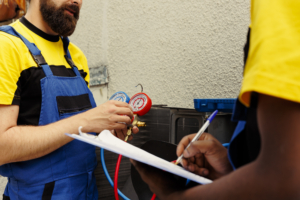Keeping Your Air Conditioner Cool and Efficient
Refrigerant is an essential component of your air conditioning system, responsible for transferring heat from your home to the outdoors. When a refrigerant leak occurs, your AC’s efficiency and cooling capacity can significantly decline. Fortunately, refrigerant leak repair is a common procedure that can restore your system’s functionality.
Understanding Refrigerant Leaks
Refrigerant leaks can occur due to various reasons, including:
- Corrosion: Over time, the metal components of your AC system can corrode, leading to leaks.
- Physical damage: Accidental damage to the refrigerant lines can cause leaks.
- Wear and tear: As your AC system ages, the seals and joints can become worn and develop leaks.
- Incorrect installation: Improper installation of your AC system can increase the risk of refrigerant leaks.
Signs of a Refrigerant Leak
Several signs can indicate a refrigerant leak in your AC system:
- Warm air: If your AC is blowing warm air instead of cool air, it’s a strong indication of a refrigerant leak.
- High energy bills: A refrigerant leak can cause your AC to work harder to achieve the desired temperature, leading to increased energy consumption.
- Unusual noises: If you hear unusual noises coming from your AC unit, it could be a sign of a leak.
- Ice buildup: Ice buildup on your AC’s outdoor unit can be a symptom of a refrigerant leak.
The Importance of Refrigerant Leak Repair
Ignoring a refrigerant leak can have serious consequences:
- Reduced cooling efficiency: A refrigerant leak can significantly reduce your AC’s ability to cool your home, leading to discomfort and higher energy costs.
- System damage: A refrigerant leak can damage other components of your AC system, such as the compressor, which can be expensive to repair or replace.
- Environmental concerns: Refrigerants are potent greenhouse gases, and releasing them into the atmosphere can harm the environment.
Refrigerant Leak Repair Process
The process of repairing a refrigerant leak typically involves the following steps:
- Leak detection: A trained technician will use specialized tools to locate the source of the refrigerant leak. This may involve using ultraviolet dye or electronic leak detectors.
- Repair or replacement: Once the leak is found, the technician will repair or replace the damaged component. This may involve soldering, brazing, or replacing a section of refrigerant tubing.
- Evacuation and recharge: After the leak is repaired, the technician will evacuate any remaining refrigerant from the system and recharge it with the correct amount of refrigerant.
- Testing: The technician will test the system to ensure that the leak has been repaired and that the AC is functioning properly.
Choosing a Reliable HVAC Technician
When selecting an HVAC technician to repair your refrigerant leak, consider the following factors:
- Experience and qualifications: Look for a technician with experience in refrigerant leak repair and the necessary certifications.
- Reputation: Read online reviews and ask for referrals from friends or family.
- Licensing: Ensure the technician is licensed to work on HVAC systems in your area.
- Warranty: Inquire about the technician’s warranty or guarantee for the repair.
Preventive Maintenance
Regular maintenance can help prevent refrigerant leaks and keep your AC system running efficiently. Consider scheduling annual maintenance checkups with a qualified HVAC technician.
A refrigerant leak can significantly impact your AC’s performance and efficiency. If you suspect a refrigerant leak, it’s essential to address the issue promptly. By choosing a reliable HVAC service provide and taking preventive measures, you can ensure your AC system operates optimally and provides comfortable cooling for your home.


